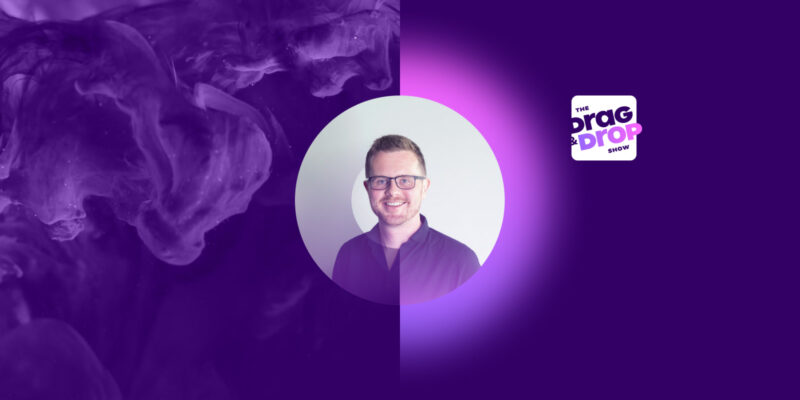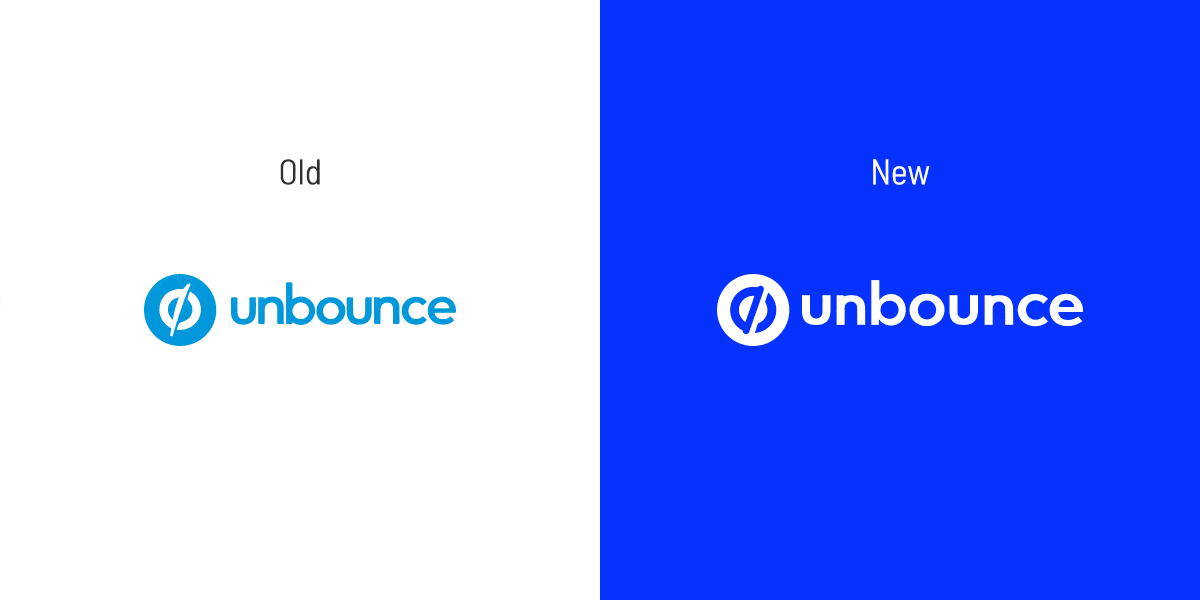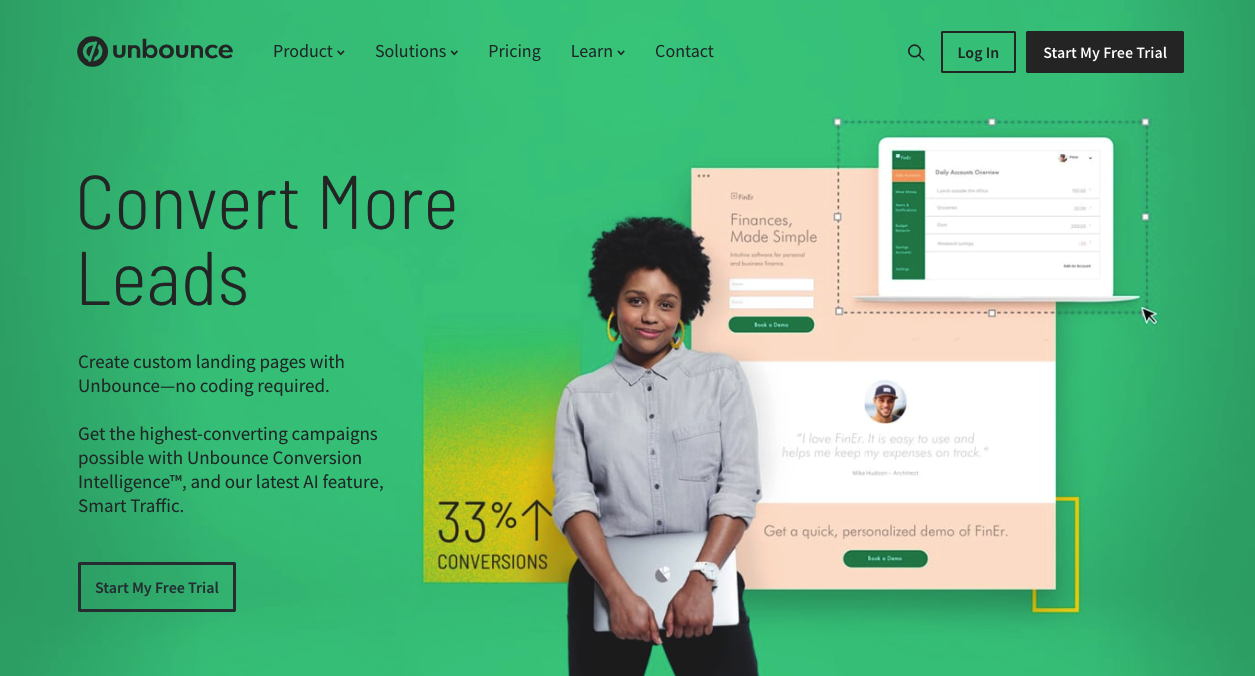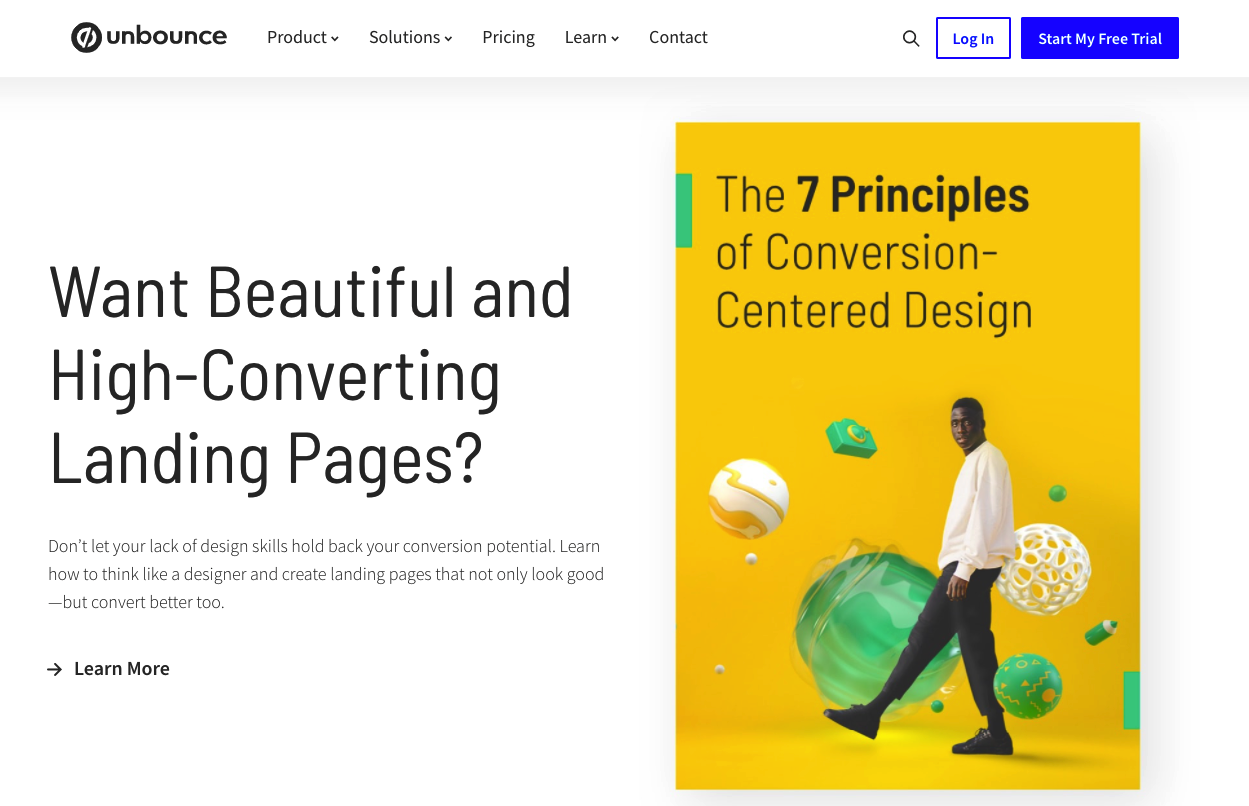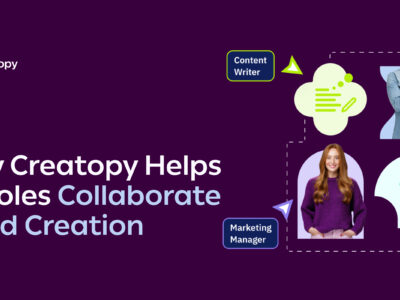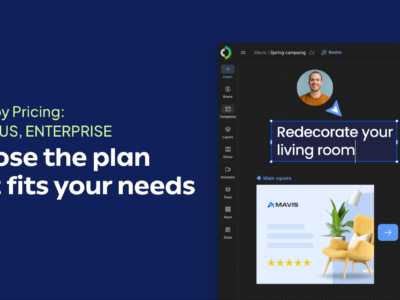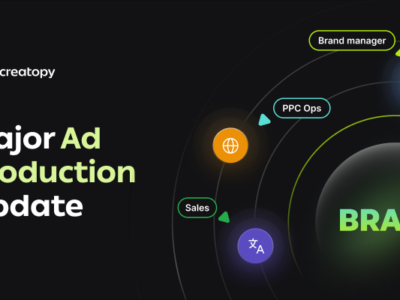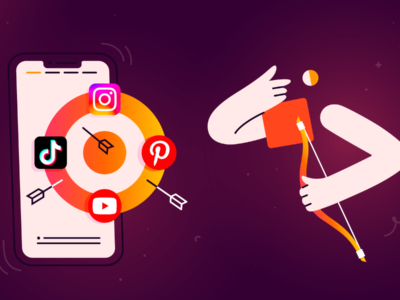As humans, we’re faced with constant change, and our ability to adapt and evolve determines our development. But is true change really possible? And is it something to strive for?
Turns out, changing has never really been the goal. Imagine turning an introvert into an extrovert. Or a rebel into a conservative. People don’t need to change and, in fact, aren’t very good at it. But here’s what they can do—they can evolve. They can turn into a better version of themselves. And so can brands.
We all have traits that make us unique: the ability to be innovative, detail-oriented, visionaries, etc. These qualities make us successful in the world. Brands experience their lifetimes in a similar way. That’s why they should always be aware of where they sit within the market and how their customers interact with the company and its services.
In this episode of The Drag & Drop Show by Creatopy, James Thomson, Senior Art Director at Unbounce, joins us in taking a look at the company’s critical rebranding decisions and some of the considerations that go into making these choices.
Discover why it’s not uncommon to get cold feet in the final stages of a brand update, see how company culture and rebranding support and strengthen one another, and find out how Unbounce used an internal launch to empower the team to roll it out to the public with a deep commitment to it.
Recognizing that we are constantly working to evolve ourselves, as people and as brands, is critical to success. Let’s dive in!
Introducing James Thomson
James is the ideal combination of a creative thinker and strategic force, with over a decade of experience in the digital media industry.
His eye for detail has allowed him to oversee the creative strategy and collaborate in agile environments across multiple companies. As a designer, he’s been building unique brand identities for years, redefining engaging user experiences while ensuring that they were delivered efficiently and to the highest standards.
James joined Unbounce at the beginning of 2019, at a critical moment in the company’s brand update process. His experience with numerous brand launches in the past proved critical for the Unbounce rebrand, portraying the process in a way that resonated both internally, as well as externally.
Stuff I Was Curious to Find Out:
- What things looked like at Unbounce before, during, and after the rebrand and how that has changed in the last year (02:09)
- How joining a team in the middle of a brand update impacts both the process and the team itself (02:39)
- The intricacies of managing expectations and reminding stakeholders and team members why the rebrand happened in the first place (07:25)
- How James implemented what he learned from previous rebrand experiences after joining Unbounce at a critical moment (15:22)
- Who was involved in the process, and what ownership looks like on a brand update project (20:20)
- Why they approached the process as an evolution, rather than a radical rebrand that changes everything (29:16)
- How they dealt with any kind of emotional attachment that people had with the former branding (36:10)
- How they measured the impact of the rebrand, seeing if it was actually effective and in tune with customers’ needs, their context, and their expectations of the brand (40:14)
- The one thing that surfaced during and after the rebrand that they found most valuable (44:51)
What You Can Learn From This Episode:
- What the foundational pieces that make up the brand architecture are (02:47)
- How to manage and mitigate those last-minute rebrand fears and jitters, on an internal basis (04:58)
- How to manage your internal process, while numerous rebrands are happening within the same space (08:52)
- The most important part of the value of a rebrand that people usually miss or skip (12:05)
- What actually triggered the initial stages of the brand evolution for Unbounce (12:55)
- How a rebrand can bring everyone closer together across the entire company (13:30)
- Why having an internal launch can help both with alignment as well as with brand dissemination (15:51)
- The ways people work together during a rebrand, taking care of different parts of that process—from the core team to collaborations (21:00)
- How doubling-down on foundational elements helped Unbounce move through the difficult times of the pandemic (25:15)
- How Unbounce evolved their brand in a way that was relevant to and inclusive of customers. What elements they kept and what they changed (29:42)
- How to deal with negative critique in a healthy and productive way (36:42)
- How to measure rebrand impact through sentiment analysis testing in the market (40:31)
Key Takeaways:
1. The need for a rebrand should come from internal values, not external influences
When everyone else is getting a refresh (a new brand strategy, updated messaging, a fresh design) you begin to look at your own brand identity with more scrutiny. But how do you know when the right moment for a rebrand is? And how do you make it happen without being influenced by the market? There are some major points that can indicate a need to rebrand, like a merger, a reputational crisis, or an internal shift. However, in many cases, the answer is not that simple.
When we need rebranding or how it happens isn’t something that should be influenced by our peers or competition. Focus on yourself. A good rebrand comes from looking at who you want to be. It implies looking at the core foundational values of the company, which then inform the style, visual representation, and tone of voice, and seeing how they’re perceived by your audience. Does that match with what you intended to portray?
2. Internal alignment can act as an anchor for a successful rebrand
When asking yourself how to plan a rebrand, remember to consider the value of the process itself. There’s a tendency to only think about the destination, the moment of crossing the finish line, forgetting about the journey itself. Remember that a rebrand is a marathon, not a sprint and that customers aren’t the only ones faced with a new brand identity—so are your employees.
Giving everyone in the company time to get comfortable with and get to know the new identity before launch, without the overlap of trying to share it with customers at the same time, can be extremely valuable. Having your coworkers feel aligned with your new vision can ensure a more natural transition that’s beneficial to everyone within the company, as well as your customers. It can create a common meeting point, a kind of shared space, both mental and emotional, where your rebrand works in perfect harmony so that people not only get results but also enjoy doing it.
3. Dealing with criticism means having strong recall yet allowing for flexibility and change
Being able to measure a brand’s evolution through the people who see it every day can be a rewarding but harsh reality. Feedback comes in all shapes and sizes, and recognizing that a rebrand is not a change, but an evolution, enables us to allow for growth through trial and error.
The best brands are ones that are built to last, seeing their core values through ever-changing trends, shifts in culture, customer demands, and critique. Don’t hide from the criticism. Instead, address these difficult conversations and see if something good and productive can come of them. Most importantly, remember the goal is not to evolve for anyone else’s sake—it’s stepping into our power and creating a better version of your company.
Transcript:
What is the difference between a rebrand and a brand update? We have the answer for you. And it comes from a company that used empathy and courage to match the internal understanding of their brand to how it was perceived externally. James Thomson – Senior Art Director at Unbounce – goes into great detail to explain how they evolved their brand to better reflect how the company had matured. He walks us through the entire brand update process, from the people involved to the public launch, with particular focus on the messy middle: the value of the process itself. Discover why it’s not uncommon to get cold feet in the final stages of a brand update and how to manage the fears that come with being hyper-aware of every single detail. Find out how Unbounce used an internal launch to empower the team to roll it out to the public with a deep understanding of it and commitment to it. It’s invigorating to see how company culture and rebranding support and strengthen one another – and Unbounce is a wonderful example of how to actually achieve this. Having powered over 1 billion conversions, the company leverages its admired corporate culture to deliver a great platform and a truly lovable brand. I’m thrilled to give you a behind-the-scenes look right now. It’s Andra Zaharia here, bringing you the latest episode of the Drag & Drop show by Creatopy!
Andra Zaharia: Hello, James, and welcome to the Drag & Drop show. We’re super excited to have you here!
James Thomson: Thanks, Andra! I’m really excited to be here, as well. Thanks for having me.
Andra Zaharia: I am so, so curious to get more inside information and an insider’s perspective on how the Unbounce rebrand unfolded and how it happened. You launched it last year, but it still feels so fresh, so powerful, and so full of energy, which, I think, that’s something everyone needs right now, especially marketers who are under a lot of pressure. So, I’m very curious to dig into what happened during the rebrand, maybe a little bit before it, and obviously, what has changed in the past year for you and the rest of the Unbounce team?
James Thomson: Sounds great. Yeah, I’m excited to talk through it.
Andra Zaharia: So what I wanted to ask is that you’re in a special position – or you were last year when you joined Unbounce. You joined the team when the rebranding process was already underway. So what was that like to come in the team when the process was kind of already developing?
James Thomson: That’s a really great question. I like to think that the position I was in coming into the company was kind of twofold in that obviously, you know, we had a bit of a challenge ahead of us in that we knew we were updating our brand over the coming months and we obviously had a lot of preparation in order to launch that. So, a lot of hard work still ahead of us and making sure that we launched in a way that was going to resonate internally within the company and then also with our audience and our market as well. But then also, it was partly an easy job because a lot of the hard work had already been done. So coming into it, a lot of the foundational pieces that made up the brand architecture had been created when I joined the company – so the auditing, a lot of the research, a lot of the development of the guidelines, and then a lot of the collateral which comes along with that had been produced. So, part of my job was also obviously quite easy because a lot of that work had been done, but it was obviously a testament to a lot of the hard work and efforts of so many people at Unbounce in a lot of different departments having collaborated really closely with each other over the 14 months that it took to do the bulk of the brand update and all of that hard work kind of accumulating in last year’s brand update.
Andra Zaharia: There’s a lot I would love to unpack there and we’re gonna go through it bit by bit. So, there was this kind of pool of work that was already there and you had to catch up really fast. Were you close to Unbounce before joining the team? What was it like to get up to speed with everything and to understand the brand’s identity and to be able to plug into that and start to work towards putting this rebrand together and then making it happen?
James Thomson: So having worked in the tech industry I had obviously been familiar with Unbounce. So part of my knowledge was already across certain aspects of their brand, which were present at the time – so some of that brand equity, which existed before we evolved our brand last year. And then coming into it, having worked on numerous brand launches in the past, it’s a case of, obviously, a lot of hard work, as I said, that had gone into that. So it was doing justice to a lot of the hard work, making sure that it would launch in a way that was going to resonate internally and externally as well. And really, a lot of the part I played in that was aligning the teams who were involved in that launch, you know, working across the different phases of which things we’re going to launch at which times, how we’re going to communicate it internally, what are the different stages of external launch, what are the different pieces of collateral which are included in that? And also just partly stakeholder management. There’s a lot of hesitation and a little bit of uncertainty, which can sometimes come from the final stages of a brand update. So, part of the job then is managing that and mitigating some of those fears internally and making sure that everyone’s really comfortable and on board with the brand when it launches so that we’re all across it internally and it’s just as seamless a launch that it can be when we launched.
Andra Zaharia: I think that’s a very interesting point that you made about getting something similar to cold feet before getting married, I think.
James Thomson: Yeah.
Andra Zaharia: Because there’s so much riding on this and you realize that it’s finally happening, and then it sets in that “Have we covered everything? Have we done everything that we could? Is there anything that we missed?” and things like that. So, given your experience – which I definitely want to go back to just a little bit further – I wanted to ask specifically about this particular aspect of managing expectations and reminding people why everything started because you start off with so much enthusiasm but by the time that the launch nears, you start to get a bit jittery and nervous. So, what is your go-to approach to dealing with this situation? Which is absolutely normal and everyone gets it no matter how hard you’ve worked, and how well you’ve done your homework, so to speak.
James Thomson: Completely. And it completely makes sense in that if you know that you’re – and then is obviously so much more of a superficial look at what a rebrand entails; it’s a lot more skin-deep than the metaphor I’m about to use. But if you know that you’re going to go out with a big group of friends and you’re debuting a new outfit, for example, you’re going to be a little bit more self-conscious of it, if it’s something you haven’t worn before, and you’re going to be a little bit more self-conscious of what people might think of that. So, it’s understandable that, obviously, something which has been brewing for a little while is going to be top of mind for people. People also, within the company, if we know that we’re launching a brand, people are going to be a lot more aware of other companies in the space as well. So a lot more aware of some of those visual elements, some of those brand traits for other companies in this space. So, you do become very hyper-aware of those things and it becomes top of mind. Whereas, in your day to day, when you’re not preparing for a rebrand, those are perhaps things which aren’t so noticeable within the company.
James Thomson: And as it is, within the six months before we evolved our brand and launched in 2019, there were numerous rebrands within the tech space, specifically within our close space, within the market. So, of course, this was going to cause questions internally. What does this mean? Is the brand too close to us? Are there certain visual elements which look like us? If we launch now does it look like we’re jumping on the rebrand bandwagon? All of these questions come out. And it’s a case of just answering them head-on and not treating these things in a silo where we kind of ignore it. You have to discuss these things head-on and kind of say, “Okay, well, what does this mean? Let’s look at this other brand. Like, what are the things which are somewhat similar? Is it really going to be detrimental to us?” And just kind of come at some of these things with some confidence also because you’ve gone through the process of evolving your brand, in that you’ve been looking internally and deciding who you want to be as a company and how you want to be represented. So, perhaps some of that has been influenced by the market – perhaps you’ve taken a look at competitors in your space – but a good rebrand, you’re really kind of looking at who you want to be. And that shouldn’t necessarily change depending on who else is in your space and who else is in your area as well. So, there’s a certain amount of staying true to the core foundational things which influenced that rebrand or that evolution in the first place and having the confidence to launch with that, even though it obviously comes with a certain amount of risk. Any rebrand comes with a certain amount of risk.
Andra Zaharia: Definitely! Especially when it’s something so big, so powerful. It kind of helps surface and crystallize all of these extremely valuable conversations about who are we? Why are we doing this? And it helps kind of form and crystallize that North Star that you were just mentioning earlier. And I find your observations so powerful because there’s so much talk of competitors and what’s going on in the space and everything moves so fast. This makes rebrands in SaaS extremely challenging because you’re going to want to capture as much as you can, you’re going to want to be as up to date and in tune with what customers want, at any point in time. But a rebrand is not only for that. It serves that purpose, but it also serves this purpose of consolidating the company’s identity, which I think is extremely powerful and I really appreciate that transparent approach to talking about these things, instead of just chucking them alongside with things that happened and that we don’t, let’s say, address because they’re uncomfortable and they spur questions upon questions that sometimes get answered and sometimes it takes just a while and a process to get to the right answers.
James Thomson: Yeah. Part of the value of a rebrand which I think some people miss or skip over when they’re going through the process of evolving their company at one stage or another, is the value of the process itself. I think a lot of people get fixated on the end goal and how we look like, how we’re perceived at the end, the big launch, the big Wow, and you miss almost like what is just as an important part of the process, which is the process itself. So the conversation which happens along the way of discussing internally who you are as a company, how you want to be perceived, does your understanding of who you are as a company internally match your external understanding as well. And that’s one of the things which actually sparked the initial stages of the brand evolution for Unbounce was that it did become obvious there was a little bit of a misalignment between our internal understanding of who we were as a company and the external perception. So, we wanted to make sure that who we were was a lot more transparent, and who we thought we were as a company was being actually represented in the market and to our customers as well.
James Thomson: So, it was the process of having those conversations. And some of those conversations are going to be difficult. There is going to be a little bit of misalignment which happens, and the important thing is for everyone to express, you know, “This is my viewpoint.” You work through the process together, you involve key stakeholders in the business – and well, the entire business along the way, ideally – in a way that everyone is then aligned, and it becomes, yes, it’s this big launch externally, but it’s this big thing internally as well, which brings everyone together in the company, and unifies you in a way that few other things can do in a company’s history.
Andra Zaharia: I love that! I love that perspective and I think that is one of the most valuable things about a rebrand – that internal alignment. And what I always saw about Unbounce, particularly, is that it is a kind of brand that is very aligned with itself. There is no big gap between what it claims it does and what it actually delivers. And that is something that I’ve always treasured about it, I’ve been learning from and I’m kind of following Unbounce for the past six years, so I’ve seen it grow and evolve at an incredible pace, and I’ve also seen the community roll around and everything else that has happened. So there was a lot to learn there and I always appreciated that the internal culture – which I knew was great and I’ve been following key people from Unbounce on Twitter and seeing the conversations they have, and how they approach things – is actually reflected into everything. And now it’s also kind of more vividly reflected in the rebrand, which I thought was very powerful and very energetic and very Unbounce-like. And it is very interesting to me, you know, that you mentioned you went through several other rebrands in your past work experiences. So I’m curious, what did you take from those experiences that particularly helped you when you joined Unbounce at that critical moment when things were coming together, but there was also a lot of work to be done in terms of alignment and actually implementing things?
James Thomson: So, I think some of the things which were top of mind going into the three to six months leading up to when we launched our evolved brand, were making sure that we did have internal alignments before we launched. So it’s super important to have internal buy-in with a new brand and for people to feel bought-in, comfortable. For some people – especially people who’ve been with companies for a longer period of time – there can be that hesitation that you have. In the case of Unbounce, there are nearly 10 years of equity there, which, obviously, people are attached to one form or another. So, in order to launch something which is visibly different, which has a slightly different style, you want for people to be across that internally, so that they’re going to exude that externally as well, especially when it comes to people within Customer Success teams, within Marketing as well. So, having an internal soft launch a few months before the external launch, from my past experience, I recognize that this is a super important thing to do. Obviously, a lot of other people at Unbounce recognize this as well.
James Thomson: And so we launched internally a few months before we were going to launch the brand, so we had turned it into – obviously it’s the celebration of a lot of the hard work which has gone into it and this huge milestone in the company. And it was a celebration, it was a town hall which we… So we have three town halls a year so we turned one of our town halls into a brand launch – a celebration town hall. This is when we were all back in the office. We served up charcuterie – we love charcuterie at Unbounce so we wanted to celebrate with a massive charcuterie plate. And of course, you walk through all of the different facets of the brand so everyone’s familiar with it, you celebrate all the different things which you’re introducing to the company and in the market and internally. And there’s a lot of little things you can include there as well. So, in our instance, we had a gift bag for all of our Unbounces where we had this swag box – so the design team designed it to be in the new brand – it had swag items within there, such as like pens, t-shirts, custom-branded chocolate. And these are things which were then living within Unbounce’s desks, within their spaces for the coming months leading up to the launch so everyone’s getting familiar with a lot of these foundational brand items, whether it’s the new colors, the new logo being applied to some of these items, but then also, you know, our values which are being communicated internally as well. So, one of the things we refreshed is our brand values and part of the internal communication – and this was to apply them to posters. So within the office, we had these posters showing what our values were in fun, typographical ways. And people were seeing these things every day in the months leading up to the external launch, so people had plenty of time to become familiar with them. So when we launched, there was, I like to think, a lot of internal alignment with that brand so that it felt like it was natural. It didn’t feel like suddenly we’re kind of switching the lights over to something very completely different. Everyone felt aligned with it and it was a very natural transition for everyone within the company, which was very important to us.
Andra Zaharia: Yeah, that to me sounds like an excellent way to go about it and it is the first time that I’ve heard about this. I know that people communicate internally and they have everything but to give that kind of buffer zone, to give that time to get comfortable and to know that this is what we do now, and not kind of overlap that with the pressure of doing it for customers and the entire community and everything else that you have to focus on at that point, I think it is extremely valuable and hopefully it will serve listeners as well into their own rebranding efforts and processes. So, you mentioned that you got, obviously, all the stakeholders get together and you aligned really well in this sense. Who was part of, let’s say, when you look at the roles that were most involved in making the decisions and in figuring out those subtle but very important aspects related to the rebrand, who were the people that were involved in this process? And I’m very curious to also find out what does ownership look like on a project like this, which deals with so many things.
James Thomson: Completely. Going through a brand evolution like the one we did at Unbounce, there are obviously so many different people involved from so many different departments, each playing a different role. And everyone is part of that process, is integral to the launch. But obviously, you have different people taking care of different parts of that process. So, you have, you know, a core working team who’s generally made up of designers, content writers – so designers working on the visual style, which is being updated, looking at logos, looking at color schemes, fonts, etc. Also, some of our foundational elements, which is our personality. And then you have a lot of collaboration between those designers and content writers who are looking at the tone of voice, who are looking at, again, our brand personality traits and how we wish for them to be showing up as well. A lot of these things are kind of being worked in collaboration between those sorts of teams. And then you have close collaboration with Customer Success. Obviously, our customer was at the forefront of our brand evolution. We wanted to move into a space where we were more externally, you know, representing customer-centric natures to our brand. And, you know, part of that was representing ourselves as being more people-first. So, Customer Success and having that customer connection was integral to that brand launch. Product Marketing as well. So, connecting with our segments in our market and having a good understanding of who our customers are was integral to that – so in close collaboration with them. And then also a collaboration with Product and UX teams, as well, partly on documentation of how we document our brand as well, but then also, in some of the processes we went through for testing, interviewing our customers to make sure that our new brand was going to resonate. And then also, you know, interviewing internally as well, interviewing so many different stakeholders within the business to get their opinions and their thoughts on how they felt we should be represented externally, to make sure that their voices were being heard and incorporated into the brand refresh as well.
Andra Zaharia: That is an extremely kind of deep way to go about it. And kind of this is why we are doing this podcast season and why we’re dedicating it to rebrands is to help more people realize if they’ve never gone through such a process and if they haven’t gone through it to the depths that you have at Unbounce, to help them realize that there are so many layers to them, that there are so many, let’s say, both personal and kind of community-related things that you have to take into account, that a rebrand is not something that’s limited to only its aesthetic part, that it’s tied to coherency to figuring out that North Star, to getting everyone to agree that this is the right direction, and to also be able to project this into the future. Because that, to me, is one of the most challenging parts. So, you’ve talked to everyone, you’ve done the research, you’ve done the work, you’ve done the internal alignment, and then you have to figure out how everything orchestrates into a vision that will last you for maybe the next decade or whenever Unbounce decides to do the next rebrand. And so much can happen in that space. So, how do you feel the rebrand has changed or has been impacted in the past year? Because you’ve had this time – which has been quite challenging for everyone – to see the rebrand at work. So I’m curious what has happened in this space?
James Thomson: Yeah, that’s a great question. Obviously, the last year being pretty intense, a lot of big changes in the world, and Unbounce living through them in the same way that obviously a lot of other companies have been. I think we were at the luxury of having gone through a brand evolution the year before a lot of these changes in the world have happened, in that we were able to double-down on some of those foundational elements, which we’d consolidated as part of the brand refresh – such as our core values – so that when, for example, the pandemic was happening, when we were all transitioning to moving from home, we ask ourselves the question, you know, how do we deal with this? What are the things we rely on? And it all comes back to who we are as a company, what our values are, what’s important to us. And those things inform how we move through these difficult times. So looking at our internal values of empathy and courage, for example – these are two values which showed up highly when we moved to working from home in the way that we would check in with each other a lot more than perhaps you would do normally, you would be a little bit courageous just to kind of see if there’s areas you might help out and lend a hand with someone else – like a different department or a different area which might be struggling. Also, making sure that everyone feels comfortable in the home space, recognizing that everyone had different environments when they were transitioning to working from home. So, making sure that you’re empathizing with different people in the company, in different environments, and being able to accommodate for that in the way that you move forward. And so, really kind of relying on a lot of those values to inform a lot of the decisions we’re making moving forward.
Andra Zaharia: That was a very powerful perspective, in my opinion. And it highlights the role that this rebrand can play into creating kind of an anchor for everyone that they can go back to whenever they feel confused, or uncertain, or troubled, or anything else like that. It creates that common meeting point, that common kind of shared space, both mental and emotional; you know, it serves many purposes. And I also think that it’s wonderful to hear that, you know, these values – and that’s what a great company culture does – don’t only reflect in the brand and the community, but it reflects in how people treat each other internally and how they walk the talk. Plus, I find that people are also naturally drawn and they will gravitate more to brands that, like Unbounce, really practice what they preach, and really provide their customers with that stability, with that ability to anticipate what they might get with that transparency, with that empathy that you mentioned and that we discussed at length in a previous podcast season. So, thank you for sharing that. That is extremely powerful and something that maybe is not immediately obvious when you do a rebrand but so much happens before a rebrand, during it, and after it that it makes it… Well, that is why we’re talking about it today, and then going into these lengths. And I loved how you constantly talk about the fact that you elevated your brand. Because I think that our listeners would like to know how the brand identity evolved because the way that you approached it at Unbounce is different than, let’s say, a radical rebrand that changes everything. You chose a different approach. Could you tell me just a little bit about that?
James Thomson: Yeah, completely. I think a lot of companies are perhaps going through the process of rebranding for a lot of different reasons. You look at companies like Miro, for example. So Miro changed their name – they used to be called RealTime Board – so it was quite a distinct change in the market in that you’re changing your name, you’re changing a lot of the visual elements which are associated with that as well. For us, we were coming up to 10 years – having been around in the market for 10 years, obviously – and it felt like there was a little bit of a disconnect – as I mentioned earlier – around how we perceived ourselves internally with what we were presenting externally as well. So we wanted to connect to those things so that they aligned a little bit more closely. But we wanted to do it in a way that we weren’t completely changing everything about ourselves, which we worked very hard to build over the 10 years. So, a lot of that brand equity we wanted to carry with us. We wanted to evolve our brand in a way that was inclusive of our customers as well. Obviously, our customer is super important to everything we do and we wanted to make sure that they were at the forefront of the brand evolution. So, looking at what those things are about our brand which we wanted to maintain. You know, the name – we wanted to keep that, it was really important to us – certain elements of the logo as well; we wanted to still be recognizable. The blue in our color palette – we wanted to retain a blue, even though we evolved it a little bit to be a little bit richer. But then, we complemented that with more of a diverse color palette as well. So we added some contrasting tones: pink, green, yellow, etc. We refined our logo so that it was more recognizable at smaller sizes and felt a little bit bolder, a little bit more representational of who we were as a company. And so, there were elements we were keeping and we wanted to retain, and then there were elements which we knew we wanted to evolve as well. One thing we wanted to put at the forefront of our brand evolution was our customers. So we wanted to make sure that we were evolving our brand in a way that was relevant to our customers and inclusive of our customers. And so when we launched the rebrand in 2019, we accompanied it with a campaign that included marketers in our space as well. So, the campaign was all around making extra your new normal and celebrating remarkable marketers who were doing great things in their space with their campaigns and shouting them out. So, part of our new brand attributes were about pushing yourself to the next level and just challenging yourself a little bit more, being a little bit more ambitious and courageous – and part of that we wanted to come across to that campaign as well. So, that’s where the ‘Make extra your new normal’ campaign came about to accompany a lot of those elements, which you’re putting out there in the market.
Andra Zaharia: And it was super impactful, from a perspective of a marketer who’s been, let’s say, on the other side, and who saw the rebrand launch and the campaign, and the way that people engaged with it, plus your Donations campaign, which you did to donate your experts’ time and your specialists’ time, and your teams’ time to NGOs and other organizations that really needed them to make a bigger impact and reach the results that they wanted to achieve. And I love the enthusiasm that accompanied everything and the level of energy and it spoke so well of everything that Unbounce had built over the last decade, exactly like you mentioned. I think that this new stage in the life of the brand is one that definitely suits Unbounce very well and that also reflects the really hard work that people do behind the scenes because to power all of these other businesses and all of these customers takes so much and it doesn’t take just technology, it doesn’t take just design, it doesn’t take just content. It takes everything and so much more and it has to work in perfect harmony so that people not only get results, but also get to enjoy doing it. So that’s something very valuable that I saw from the outside.
James Thomson: Completely. And that campaign aligned with so many things about our brand that we wanted to put out there as well, like a lot of our core values internally. And, as you mentioned, in the campaign, we did partner with PeaceGeeks. So, for every marketer who was shouted out on social media, we dedicated some of our time to supporting PeaceGeeks – obviously a non for profit. So, part of that give-back once we’d finished the campaign was to then do a bit of a slam with PeaceGeeks. So we supported them in some of their upcoming campaigns, and then some work on their website, etc. So, really kind of collaborating with marketers pretty closely, which folded really nicely into some of the brand attributes, which was part of that brand evolution.
Andra Zaharia: Did you deal with any kind of emotional attachment that people had with the former brand and everything that it looked like, either in the community or internally as well? You did mention this internally, but was there any not necessarily resistance, but that pang of nostalgia that people sometimes get?
James Thomson: From the community and externally in particular?
Andra Zaharia: Yes.
James Thomson: Yeah. I think for any change, you’re always going to receive critique. And critique is going to be obviously very positive from a lot of different places but then there’s always a chance you’ll receive some negative critique as well. So there’s a certain aspect of change in anything which changes, especially something which has been familiar to someone for a long period of time, such as 10 years. You’re familiar with certain colors or a certain style, certain visual attributes, etc. And when that changes, it can cause a little bit of confusion. What does this mean? What does this mean to me as well? So, it’s understandable that you’ll receive some feedback which is along those lines. But I don’t think there’s been any sort of significant rebrand which hasn’t received any level of critique along those lines in general. When Instagram updated their icon to the current version, it was met with extreme critique. But now, obviously, people associate that with Instagram, and it feels, you know, part of the brand, it feels very natural. You know, the same with a lot of other companies. The Eiffel Tower, when the Eiffel tower was built in France, it was called the Concrete Monstrosity. Now, it’s probably the most romantic symbol in the world and everyone obviously associates it with Paris, even though it was originally meant to be a temporary structure.
James Thomson: So, the important thing is to take some of the critiques with a grain of salt and just make sure internally that you’re talking about these things, you’re having a conversation, you’re not sweeping it under the rug and hiding it. You’re addressing these conversations forward by saying, “Hey, what do we think about this? Do we agree with this? Maybe there’s a couple of valid points here and there, but… You know, that conversation is great, but does that mean that you need to go back to the drawing board and refresh every time someone critiques your brand? Probably not. Otherwise, you’d be refreshing your brand every three months. So the important thing is to address it not hide it, have conversations around it, and know that sometimes you are going to receive… Feedback comes in all shapes and sizes.
Andra Zaharia: It does.
James Thomson: The good thing is that most of it was positive. So, thankfully, that was good. In our case, at least.
Andra Zaharia: Absolutely. And it’s a testament to all of the work done in terms of research, in terms of talking to people and actually understanding their context and where they come from and what they value and everything else. It’s everything that God poured into the rebrand and, you know, to me that is one of the ways to minimize risk in a way that’s actually effective and that’s actually very in tune with customers’ needs, and their context, and their expectations of their brand. And that sort of communication on all of these levels, and on all of these very subtle aspects, that has a huge compound effect, and it makes a whole lot of difference. And speaking to how people received the Unbounce rebrand, I was very curious, how did you measure the impact of the rebrand? What did you look at to see if what you expected to happen was happening?
James Thomson: Yeah. So, as I mentioned, when we were originally doing an audit of all of our different brand collateral, we were also doing some sentiment analysis testing in the market. So, we would share current brand pieces with our customers and then just kind of ask questions like, what do you think about this? Out of these words, which words do you associate with the current Unbounce brand? And this forms a picture of how people are perceiving certain aspects of your brand on a top-level, and then you follow up with a little bit more in-depth interviews to get a little bit more understanding as to what some of those things mean. So we were finding that there’s certain aspects of our brand which were being perceived as a little bit more boring, a little bit more robotic and, internally, we felt like we were a very human brand, a very people-focused, customer-centric, but obviously, that wasn’t being exuded externally. So, looking at those sentiments and saying, “Okay, well, we want to be able to change those over time. What are the things we want to represent externally? How do we want to change those sentiments?” So then going through the process of brand update, and then after it launches a little bit on, it’s important to then re-address the market and your customers with a similar sort of exercise. So, we went back and said, “Okay, how are you feeling about the Unbounce brand? What sort of sentiment are you getting from it?” And it was great to see that there was definitely a lot more sentiment around being obviously more human, less robotic, less cold and unapproachable. And I think a lot of this was the nature of some of the visuals we were using, and obviously, our tone of voice as well, and that it was becoming a lot more conversational, we were representing more people, we were less reliant on illustration, which can sometimes be a little bit more cold and robotic as well. So, it was great to see after, you know, six months on – even just six months in the market – getting that sentiment analysis back from some of those interviews and seeing that the perception had already changed, which is great. So, being able to measure a brand’s evolution through the people who are seeing it every day is so important. So, asking them what they feel about it, what are those things they associated through a sentiment analysis or through an interviewer are pretty integral ways to measure how it’s resonating, and whether that matches with how you want it to resonate in the market.
Andra Zaharia: I love that you’re taking the most painstaking approach to it, that you’re taking the customer interviews approach to it because, obviously, quantitative data – and I know Unbounce loves data, and it’s doing such great things with it – but at the same time, you’re looking to capture the whole context. And there is no better way, from my own experience as well, to do that, than to actually talk to people and understand where they’re coming from in ways that are both related and unrelated to the brand because everything matters and everything goes into that decision and into that perception. So, thank you for sharing that with me. I think that is a very valuable kind of piece of advice to always keep in mind that these conversations that obviously are incredibly valuable when they happen all the time but they’re all the more important when they need to evaluate the impact of a project like a huge rebrand in the market. You’ve shared so many rich insights with us about the soft launch, about all the sometimes difficult but always valuable conversations that you had around risks and around what you wanted to keep from Unbounce’s 10-year history, what you wanted to evolve and how, and how you got people to work together, to communicate, and to build this rebrand and to launch it. And since we started with your perspective and your personal perspective and how it all started for you, I was wondering if you could share with us what was the one thing that surfaced from you through this entire process and maybe after it? What’s one thing that you took away that you found extremely valuable that might serve other specialists that get involved in rebrands as well?
James Thomson: One thing out of so many!
Andra Zaharia: There can be more. We can do a top three, a top-five?
James Thomson: It’s a great question. I think one thing, going back to what we discussed around some of the trepidation, i.e. internally you can have surrounding the lead up to a rebrand and the fear of putting it out there and, you know, what if we make a mistake? What if we do the wrong thing? I think there’s always going to be those things to a certain extent. I think it’s important to remember that, you know, a brand is a big part of culture, but just because you evolve certain parts of a brand it doesn’t mean your culture is going to suddenly change overnight or it might not even change at all. Culture is something which in many businesses, I think is, if you have a strong pre-existing culture, that’s going to live on whether you’ve completely changed the front of your company or not. And that is still going to be something which is existing past a rebrand, it’s still going to live on. Something almost evergreen about culture in a company is it’s always going to be there in one form or another. So, reminding people of that I think is pretty important in that we have this culture which is always going to be here for us.
James Thomson: And then some other lessons and things which just kind of come top of mind as I kind of look back on the rebrand or the brand evolution. So, it’s interesting when companies evolve their visual style – so you might look at what everyone else in the market is doing. So, you look at all of these different styles in the market and you say, “Okay, perhaps everyone is using illustration right now.” So illustration is something which has become maybe a little bit stagnant in the industry, and maybe illustration is something we want to avoid. So we want to evolve to use more photography, we want to use more people-focused imagery, less illustration, perhaps less iconography. So you start to create something unique and it feels very unique for you. And then, as was our case, we saw that other companies started to launch with very people-first photography led brand updates in the six months leading up to our brand update. So then you start to have the questions internally of “Okay, well, do we still launch a photography-first brand? Do we still go with this style? What if everyone has this same sort of style?” And I think – I know I mentioned this earlier – a good solid rebrand or brand evolution comes from having addressed very core foundational things about the company, which then inform the style, which then inform the tone of voice. So, you know, the visual representation is one expression of some of those foundational things you’ve aligned on. So, I think the important thing is to align on those core foundational elements. And then, you know, the visual side is secondary to that in that it’s a representation of a lot of those foundational things. So, you almost have to just say, “Well, this is right for us because this is the sort of company we want to be, regardless of how everyone looks and how everyone else is perceiving themselves and putting themselves across in the market. This is true to us and who we are in our core, and we want to be represented this way, regardless of perhaps whether there’s a couple of other companies who maybe look a little similar. That’s fine.” The important thing is how you want to be perceived as a company out there and almost, you know, just go for it, put yourself out there and take that risk, and don’t look back.
Andra Zaharia: And that’s how all the great things happen, don’t they? When we’re true to ourselves and when we’re doing something that aligns with us and that makes us feel right, when there’s less and less or none of that internal conflict. And that’s when you know that culture feels right, that a rebrand feels right, that interacting or making a choice to be someone’s customer feels right. I feel like the internal alignment with ourselves is kind of what we’re all craving for these days and I’m so glad to have gone under your guidance through this entire story and figure out how to make things happen. And I think that there are many powerful lessons in everything that you’ve shared with us, not just for other people working on brands or rebrands but generally, for people looking to evolve themselves and their kind of approach to work, to getting involved in the community, to expressing themselves and to standing out, which is something that I know more people could use a little bit more confidence in their own choices. Thank you so, so much, James, for your time and for your generous insights and for helping us go even further into the Unbounce rebrand. This has been extremely insightful and it’s been, well, let’s say a dream come true, given that I’ve seen Unbounce from the outside, and having a chance to peek in was extremely exciting. Thank you for everything!
James Thomson: Thank you, Andra. It’s been a pleasure to talk about some of these things with you and re-live a lot of the experiences we went through in going through the brand evolution in 2019. It was great to revisit a lot of these things with you. Thanks for having me!
Andra Zaharia: My pleasure.
Connect With James:
Resources Mentioned in the Episode:
- Unbounce.com
- Article – Unbounce [Brand Reveal] Celebrating You with a New Look
- Unbounce on Twitter
- Office photos – Unbounce Town Hall
- Miro
- Website – Miro rebranding
- Article – Unbounce [Brand Reveal] Let’s Make Extra Your New Normal
- PeaceGeeks
Thanks for Tuning In
The Drag & Drop Show is an original series created by Creatopy.
Click here to give Creatopy a spin.
If you liked this episode, hit “Subscribe” to get notified of the latest episodes wherever you get your podcasts:

